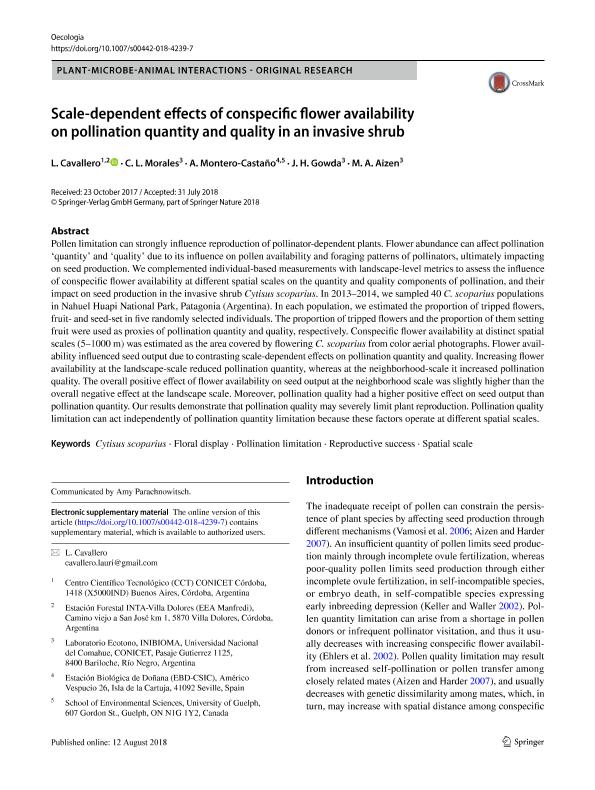Mostrar el registro sencillo del ítem
dc.contributor.author
Cavallero, Laura

dc.contributor.author
Morales, Carolina Laura

dc.contributor.author
Montero Castaño, Ana

dc.contributor.author
Gowda, Juan Janakiram Haridas

dc.contributor.author
Aizen, Marcelo Adrian

dc.date.available
2020-01-03T17:50:06Z
dc.date.issued
2018-10
dc.identifier.citation
Cavallero, Laura; Morales, Carolina Laura; Montero Castaño, Ana; Gowda, Juan Janakiram Haridas; Aizen, Marcelo Adrian; Scale-dependent effects of conspecific flower availability on pollination quantity and quality in an invasive shrub; Springer; Oecologia; 188; 2; 10-2018; 501-513
dc.identifier.issn
0029-8549
dc.identifier.uri
http://hdl.handle.net/11336/93428
dc.description.abstract
Pollen limitation can strongly influence reproduction of pollinator-dependent plants. Flower abundance can affect pollination ‘quantity’ and ‘quality’ due to its influence on pollen availability and foraging patterns of pollinators, ultimately impacting on seed production. We complemented individual-based measurements with landscape-level metrics to assess the influence of conspecific flower availability at different spatial scales on the quantity and quality components of pollination, and their impact on seed production in the invasive shrub Cytisus scoparius. In 2013–2014, we sampled 40 C. scoparius populations in Nahuel Huapi National Park, Patagonia (Argentina). In each population, we estimated the proportion of tripped flowers, fruit- and seed-set in five randomly selected individuals. The proportion of tripped flowers and the proportion of them setting fruit were used as proxies of pollination quantity and quality, respectively. Conspecific flower availability at distinct spatial scales (5–1000 m) was estimated as the area covered by flowering C. scoparius from color aerial photographs. Flower availability influenced seed output due to contrasting scale-dependent effects on pollination quantity and quality. Increasing flower availability at the landscape-scale reduced pollination quantity, whereas at the neighborhood-scale it increased pollination quality. The overall positive effect of flower availability on seed output at the neighborhood scale was slightly higher than the overall negative effect at the landscape scale. Moreover, pollination quality had a higher positive effect on seed output than pollination quantity. Our results demonstrate that pollination quality may severely limit plant reproduction. Pollination quality limitation can act independently of pollination quantity limitation because these factors operate at different spatial scales.
dc.format
application/pdf
dc.language.iso
eng
dc.publisher
Springer

dc.rights
info:eu-repo/semantics/openAccess
dc.rights.uri
https://creativecommons.org/licenses/by-nc-sa/2.5/ar/
dc.subject
CYTISUS SCOPARIUS
dc.subject
FLORAL DISPLAY
dc.subject
POLLINATION LIMITATION
dc.subject
REPRODUCTIVE SUCCESS
dc.subject
SPATIAL SCALE
dc.subject.classification
Ecología

dc.subject.classification
Ciencias Biológicas

dc.subject.classification
CIENCIAS NATURALES Y EXACTAS

dc.title
Scale-dependent effects of conspecific flower availability on pollination quantity and quality in an invasive shrub
dc.type
info:eu-repo/semantics/article
dc.type
info:ar-repo/semantics/artículo
dc.type
info:eu-repo/semantics/publishedVersion
dc.date.updated
2019-10-10T13:58:04Z
dc.journal.volume
188
dc.journal.number
2
dc.journal.pagination
501-513
dc.journal.pais
Alemania

dc.journal.ciudad
Berlín
dc.description.fil
Fil: Cavallero, Laura. Instituto Nacional de Tecnología Agropecuaria. Centro Regional Córdoba. Estación Experimental Agropecuaria Manfredi. Estación Forestal Villa Dolores; Argentina. Consejo Nacional de Investigaciones Científicas y Técnicas. Centro Científico Tecnológico Conicet - Córdoba; Argentina
dc.description.fil
Fil: Morales, Carolina Laura. Consejo Nacional de Investigaciones Científicas y Técnicas. Centro Científico Tecnológico Conicet - Patagonia Norte. Instituto de Investigaciones en Biodiversidad y Medioambiente. Universidad Nacional del Comahue. Centro Regional Universidad Bariloche. Instituto de Investigaciones en Biodiversidad y Medioambiente; Argentina. Universidad Nacional del Comahue. Centro Regional Universitario Bariloche. Laboratorio de Ecotono; Argentina
dc.description.fil
Fil: Montero Castaño, Ana. University of Guelph; Canadá. Consejo Superior de Investigaciones Científicas. Estación Biológica de Doñana; España
dc.description.fil
Fil: Gowda, Juan Janakiram Haridas. Universidad Nacional del Comahue. Centro Regional Universitario Bariloche. Laboratorio de Ecotono; Argentina. Consejo Nacional de Investigaciones Científicas y Técnicas. Centro Científico Tecnológico Conicet - Patagonia Norte. Instituto de Investigaciones en Biodiversidad y Medioambiente. Universidad Nacional del Comahue. Centro Regional Universidad Bariloche. Instituto de Investigaciones en Biodiversidad y Medioambiente; Argentina
dc.description.fil
Fil: Aizen, Marcelo Adrian. Consejo Nacional de Investigaciones Científicas y Técnicas. Centro Científico Tecnológico Conicet - Patagonia Norte. Instituto de Investigaciones en Biodiversidad y Medioambiente. Universidad Nacional del Comahue. Centro Regional Universidad Bariloche. Instituto de Investigaciones en Biodiversidad y Medioambiente; Argentina. Universidad Nacional del Comahue. Centro Regional Universitario Bariloche. Laboratorio de Ecotono; Argentina
dc.journal.title
Oecologia

dc.relation.alternativeid
info:eu-repo/semantics/altIdentifier/url/https://link.springer.com/article/10.1007%2Fs00442-018-4239-7
dc.relation.alternativeid
info:eu-repo/semantics/altIdentifier/doi/http://dx.doi.org/10.1007/s00442-018-4239-7
Archivos asociados
